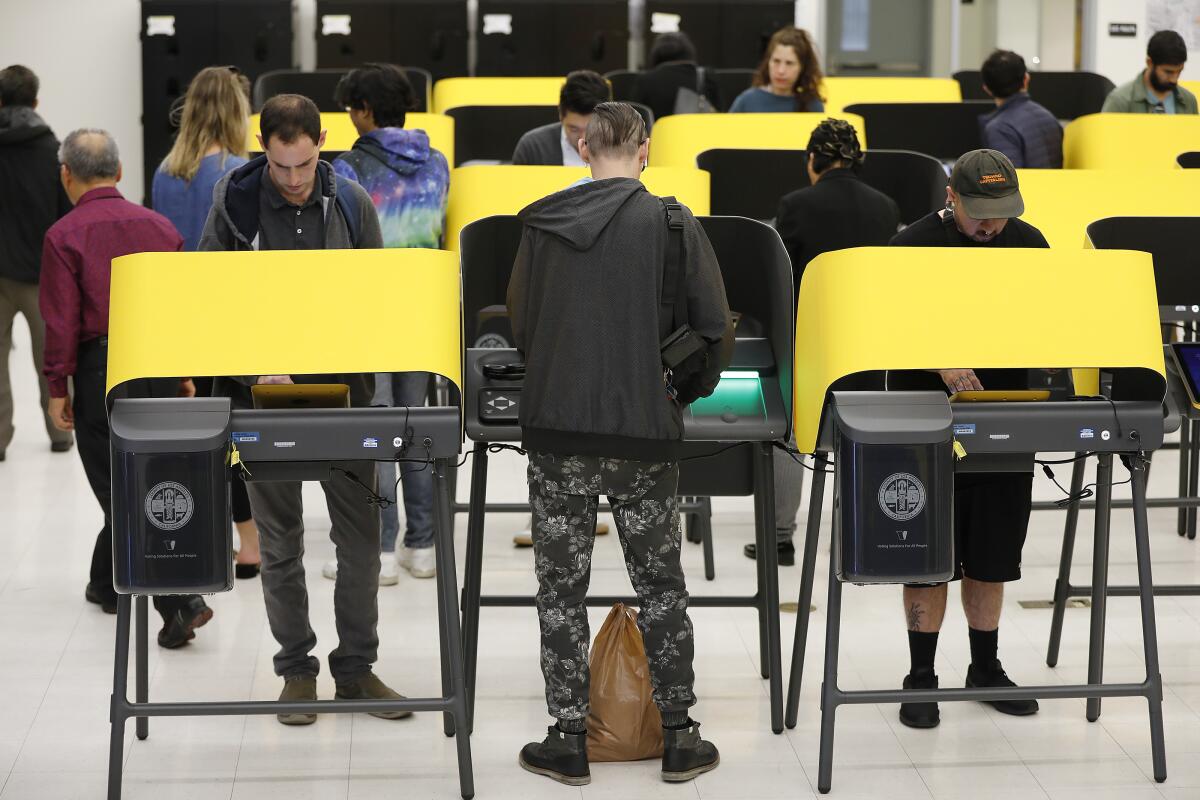L.A. County primary voting was plagued with technology flaws

The delays and long lines that marred voting in Los Angeles County’s March 3 primary election were due largely to a key component of the county’s new $300-million electronic voting system, which was designed to check in voters at polling places but was hampered by slow digital communication links, according to a recent report by the county.
The highly-anticipated voting system, the first major changes in the county’s voting process in more than a decade, relied on electronic poll books to register voters at centers across the region. But the poll books, the digital equivalent of paper voter rolls used at traditional polling places, suffered from major delays due to network and capacity issues, according to the report by the the Los Angeles County Registrar’s Office.
The delays left thousands of voters frustrated, and the problems were compounded by election workers who lacked the authority and training to address the issues.
“Even though ample network bandwidth was available, the PollPads had issues synchronizing data with the voter database and the voter search function was too limited for the size of the county’s electorate,” according to the report, which was posted on the registrar’s website in late April and was not formally announced.
The stakes were exceptionally high for L.A. County elections officials in the presidential primary. Two significant changes in the voting experience were put in place at the same time, all while turnout was expected to be high among those voting in the Democratic presidential contest.
For one, it was the first countywide election using new voting machines developed over the course of a decade by local officials with community input. The devices, which mark paper ballots with choices that voters make using a touch screen, are unlike those used in any other county in California.
Secondly, the March election was also the first held in the county using the “vote center” model enacted by California lawmakers under the Voter’s Choice Act. The 2016 law allows the elimination of neighborhood polling places in exchange for a more limited number of multi-purpose vote centers — locations where voters can update their voter registration and cast a ballot as early as 10 days before election day.
Dean Logan, the Los Angeles County registrar-recorder/county clerk, did not directly address the system’s flaws in a statement to The Times. His office said the report was completed in late April by a third-party consultant. The report recommends an “action plan” that includes working with state officials to address synchronization issues with the poll books, as well as tracking wait times at vote centers and posting the wait times in real time through an app.
“We are heads-down, all hands on deck working with the full support and collaboration of the county, stakeholders and the secretary of state to address the action plans in our report, new challenges associated with COVID-19 and to ensure a positive, accessible voting experience this fall,” Logan said.
Supervisor Janice Hahn, who was a vocal proponent of investigating the failures, said she remains concerned about the system’s capacity to function properly in future elections.
“The problems voters experienced in March were unacceptable and this report proves that they can’t all be blamed on technology,” Hahn said in a statement. “The registrar-recorder has a lot of work to do regaining the confidence of the public.”
The voting system is used in other counties, but the approach used in Los Angeles County differed in one important area. While other counties mailed ballots to every registered voter, L.A. County was given special permission by the Legislature to skip that step, forcing some 2 million voters who didn’t receive an absentee ballot to crowd regional vote centers.
That proved too much of a burden to the new system that relied on the electronic poll books to check in voters at the 970 regional vote centers. Because a voter can cast a ballot at any vote center, the tablet devices must be able to access the records of all 5.5 million L.A. County voters to ensure the person is registered and to update the records showing the voter has cast a ballot in that election.
Even though there was enough network bandwidth, it took in some cases two hours to update them. The devices were configured to stop an update if it took more than 15 minutes, making it impossible to download the latest data from the county’s voter database.
On the afternoon of election day, the cutoff for syncing the data was changed to 30 minutes, but even then, many poll books did not complete synchronization, and as a result, continued to prompt election workers to issue provisional ballots.
There were also staffing issues.
The county recruited the overall number of election workers needed, but some vote centers were overstaffed while others lacked enough workers. Additionally, requiring vote center management to work 11 consecutive days caused attendance issues and made it challenging to fill those leadership roles.
Additionally, worker training started while the county was still developing its election day procedures, which meant workers learned different things depending on when they were trained, on top of already having to learn new technology and procedures under the vote center model.
And when the election workers asked for help, they had to wait to get it.
“The help desks where election workers and voters call to get help did not have adequate staff needed to respond to incoming call volume promptly,” according to the report. “Technical issues with the telephone system also led to excessive wait times.”
Almost 1 million voters used the voting centers, and one in five reported having a negative experience, according to post-election surveys and exit polls.
More to Read
Sign up for Essential California
The most important California stories and recommendations in your inbox every morning.
You may occasionally receive promotional content from the Los Angeles Times.













